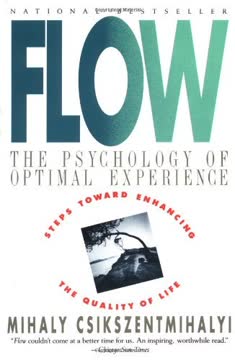Key Takeaways
1. Lateral thinking complements vertical thinking for problem-solving
Logic is the tool that is used to dig holes deeper and bigger, to make them altogether better holes. But if the hole is in the wrong place, then no amount of improvement is going to put it in the right place.
Vertical vs. lateral thinking. Vertical thinking is a logical, step-by-step approach to problem-solving, while lateral thinking involves exploring unconventional and creative paths. Vertical thinking excels at refining existing ideas and processes, but it can be limited by its linear nature. Lateral thinking, on the other hand, allows for unexpected connections and novel solutions.
Complementary nature. The most effective problem-solving occurs when both vertical and lateral thinking are employed. Lateral thinking generates new ideas and perspectives, while vertical thinking evaluates and refines them. This combination allows for both innovation and practicality in addressing challenges.
- Examples of vertical thinking: Mathematical proofs, legal arguments
- Examples of lateral thinking: Brainstorming sessions, analogical reasoning
- Synergy: Use lateral thinking to generate multiple solutions, then vertical thinking to analyze and implement the best one
2. Dominant ideas can inhibit creative solutions
The mind is happier enlarging by logic an existing hole, and because education has encouraged this and society has elected experts to see that it is done, there are a lot of well-developed holes continually enlarging under the impact of logical effort.
Recognizing mental blocks. Dominant ideas are established concepts or approaches that can become so ingrained that they prevent us from considering alternative solutions. These mental blocks often arise from education, experience, or societal norms, and can limit our ability to think creatively.
Overcoming fixation. To generate truly innovative ideas, it's crucial to identify and challenge dominant ideas. This process involves consciously examining our assumptions and actively seeking alternative perspectives. By doing so, we open ourselves up to a broader range of possibilities and potential solutions.
Techniques for identifying dominant ideas:
- Write down all assumptions about a problem
- Ask "What if the opposite were true?"
- Seek input from people outside your field
Benefits of challenging dominant ideas: - Increased innovation
- Improved problem-solving capabilities
- Enhanced adaptability in changing environments
3. Breaking patterns and assumptions unleashes new perspectives
To cultivate a pleasure in being wrong sounds perverse, yet losing an argument means escaping from an old idea and the acquisition of a new way of looking at things.
Embracing uncertainty. Breaking established patterns and assumptions is a key component of lateral thinking. This process involves deliberately challenging our habitual ways of thinking and being open to being wrong. By embracing uncertainty and ambiguity, we create space for new ideas to emerge.
Techniques for pattern-breaking. There are various methods to disrupt our typical thought patterns and generate fresh perspectives. These techniques often involve introducing randomness, reversing assumptions, or combining unrelated concepts.
Pattern-breaking exercises:
- Random word association: Connect a random word to your problem
- Reverse assumptions: List assumptions, then consider their opposites
- Analogical thinking: Apply solutions from unrelated fields to your problem
Benefits of breaking patterns: - Increased creativity and innovation
- Enhanced problem-solving abilities
- Greater flexibility in thinking and decision-making
4. Chance and randomness play a crucial role in generating ideas
Chance has no limits, but imagination has.
Harnessing serendipity. Chance events and random occurrences can often lead to breakthrough ideas and innovations. By creating an environment that allows for and encourages these chance encounters, we increase the likelihood of stumbling upon novel solutions.
Structured randomness. While we can't control chance itself, we can create conditions that maximize our exposure to diverse stimuli and unexpected connections. This structured approach to randomness involves deliberately seeking out new experiences, information, and perspectives.
Ways to incorporate randomness:
- Explore unfamiliar subjects or environments
- Engage in unstructured play or experimentation
- Use random input techniques in brainstorming sessions
Historical examples of chance-driven innovations: - Penicillin (Alexander Fleming)
- X-rays (Wilhelm Roentgen)
- Post-it notes (Spencer Silver and Art Fry)
5. Simplicity and effectiveness are the hallmarks of lateral thinking
The ideal aimed at in lateral thinking is the simplicity of extreme sophistication, the simplicity of an idea that is very effective in action and yet elemental in its form.
Elegant solutions. The goal of lateral thinking is not complexity, but rather finding simple, elegant solutions to problems. These solutions are characterized by their effectiveness and efficiency, often appearing obvious in hindsight despite being non-intuitive at first.
Iterative refinement. Achieving simplicity often requires multiple iterations and refinements. The process involves generating numerous ideas, then distilling them down to their essential components. This approach leads to solutions that are both powerful and easy to implement or understand.
Characteristics of effective lateral thinking solutions:
- Simplicity in design or concept
- High impact relative to effort or resources required
- Unexpected or non-obvious approach
Examples of simple yet effective solutions: - Velcro (inspired by burrs sticking to clothing)
- Wheel luggage (a simple addition that revolutionized travel)
- QR codes (efficient information storage in a simple visual format)
6. Practical applications of lateral thinking extend beyond invention
The mother who put her child in a play-pen to stop him pulling the Christmas tree to bits was using one sort of thinking; the husband who decided it made more sense to put the tree into the play-pen instead was using another sort of thinking.
Everyday problem-solving. Lateral thinking is not limited to scientific or technological innovation; it has practical applications in everyday life. By applying lateral thinking principles to common situations, we can find creative solutions to routine problems and improve our daily experiences.
Diverse fields of application. The principles of lateral thinking can be applied across various disciplines and industries. From business strategy to personal relationships, lateral thinking offers a fresh approach to challenges in any domain.
Areas where lateral thinking can be applied:
- Business: Product development, marketing strategies, organizational structure
- Education: Curriculum design, teaching methods, student engagement
- Personal life: Relationship issues, time management, personal growth
Benefits of applying lateral thinking in daily life: - Increased adaptability to change
- Improved decision-making skills
- Enhanced creativity in problem-solving
7. Humor and lateral thinking share cognitive mechanisms
Humour occurs when the most probable way of looking at things is disrupted by a sudden appreciation that there is another way of looking at them.
Cognitive shift. Both humor and lateral thinking involve a sudden shift in perspective or understanding. In humor, this shift creates a pleasant surprise or incongruity that results in laughter. In lateral thinking, it leads to new ideas or solutions.
Training the mind. Engaging with humor can help develop the mental flexibility required for effective lateral thinking. By appreciating and creating humor, we exercise our ability to see situations from multiple angles and make unexpected connections.
Similarities between humor and lateral thinking:
- Both involve unexpected connections or perspectives
- Both require mental flexibility and openness
- Both can lead to insights or "aha" moments
Ways to cultivate humor for improved lateral thinking: - Practice creating and appreciating wordplay
- Engage in improvisational comedy exercises
- Analyze the structure of jokes and comedic situations
8. Overcoming resistance to new ideas is crucial for innovation
No one is interested in new ideas as such but only in effective new ideas.
Barriers to acceptance. New ideas often face resistance due to various factors, including risk aversion, attachment to existing methods, and difficulty in evaluating unfamiliar concepts. Overcoming this resistance is essential for innovation to flourish.
Strategies for idea adoption. To increase the likelihood of new ideas being accepted and implemented, it's important to consider both the merits of the idea itself and the way it is presented. Effective communication, demonstration of value, and addressing potential concerns can all contribute to successful idea adoption.
Common reasons for resistance to new ideas:
- Fear of failure or financial loss
- Comfort with the status quo
- Difficulty in evaluating potential impact
Techniques for promoting idea acceptance: - Clearly demonstrate the idea's value and potential impact
- Address potential concerns or objections proactively
- Start with small-scale implementations or pilot projects
- Build a coalition of supporters within the organization
Last updated:
FAQ
What's "Lateral Thinking: An Introduction" about?
- Overview of the book: "Lateral Thinking: An Introduction" by Edward de Bono explores the concept of lateral thinking, a method of thinking that encourages creativity and problem-solving by looking at situations from different angles.
- Purpose of lateral thinking: The book argues that conventional vertical thinking often limits our ability to generate new ideas, while lateral thinking offers a more natural and effective way to develop simple and sound solutions.
- Historical context: First published in 1967, the book remains relevant today, emphasizing the importance of creativity and innovation in both personal and professional contexts.
Why should I read "Lateral Thinking: An Introduction"?
- Develop creativity: The book provides insights into how lateral thinking can enhance your creative abilities, making it a valuable read for anyone looking to improve their problem-solving skills.
- Practical applications: It offers practical guidance on how to apply lateral thinking techniques in various aspects of life, from business to personal challenges.
- Timeless relevance: Despite being published decades ago, the principles of lateral thinking are still applicable in today's fast-paced and competitive world.
What are the key takeaways of "Lateral Thinking: An Introduction"?
- Vertical vs. lateral thinking: The book distinguishes between vertical thinking, which is logical and sequential, and lateral thinking, which is more creative and exploratory.
- Breaking mental patterns: It emphasizes the importance of breaking free from dominant ideas and habitual thinking patterns to discover new solutions.
- Encouraging innovation: Lateral thinking is presented as a skill that can be developed to foster innovation and adaptability in various fields.
How does Edward de Bono define lateral thinking?
- Definition: Lateral thinking is defined as a method of thinking that involves looking at problems from different perspectives and generating new ideas by breaking away from traditional logical processes.
- Contrasts with vertical thinking: Unlike vertical thinking, which follows a linear and logical path, lateral thinking encourages exploring multiple possibilities and embracing uncertainty.
- Practical skill: De Bono emphasizes that lateral thinking is a skill that can be learned and practiced, much like riding a bicycle or baking a cake.
What are some techniques for developing lateral thinking?
- Challenge assumptions: One technique involves questioning and challenging existing assumptions to open up new possibilities.
- Use of analogies: Employing analogies and metaphors can help in viewing problems from different angles and generating creative solutions.
- Random stimulation: Introducing random elements or stimuli can disrupt conventional thinking patterns and lead to innovative ideas.
How does "The Black Pebble" story illustrate lateral thinking?
- Story summary: The story involves a girl who must choose a pebble from a bag to save her father from debt, knowing the money-lender has placed two black pebbles in the bag.
- Lateral solution: Instead of choosing a pebble, the girl drops it and suggests checking the remaining pebble to determine her choice, thus outsmarting the money-lender.
- Lesson: The story demonstrates how lateral thinking can transform an impossible situation into an advantageous one by shifting focus and perspective.
What role does chance play in lateral thinking according to Edward de Bono?
- Chance as a tool: De Bono suggests that chance can be a valuable tool in generating new ideas by providing unexpected stimuli and opportunities for creative thinking.
- Encouraging randomness: He advocates for creating environments where chance interactions can occur, such as brainstorming sessions or playful experimentation.
- Harvesting outcomes: The key is to recognize and capitalize on the outcomes of chance events, turning them into innovative solutions.
How can lateral thinking be applied in business and innovation?
- Problem-solving: Lateral thinking can be used to find creative solutions to business challenges, such as improving processes or developing new products.
- Competitive advantage: By fostering a culture of lateral thinking, businesses can gain a competitive edge through innovation and adaptability.
- Cost-saving ideas: It can also lead to cost-saving measures by identifying more efficient ways of doing things or utilizing resources.
What are the limitations of vertical thinking as discussed in the book?
- Inhibits creativity: Vertical thinking, with its focus on logic and sequence, can inhibit creativity by reinforcing existing patterns and assumptions.
- Limited problem-solving: It often leads to solutions that are predictable and conventional, missing out on innovative possibilities.
- Need for balance: De Bono argues for a balance between vertical and lateral thinking, using the strengths of both to achieve effective problem-solving.
How does Edward de Bono suggest overcoming dominant ideas?
- Identify and expose: One technique is to deliberately identify and expose dominant ideas that may be limiting new thinking.
- Distort and challenge: Another approach is to distort or exaggerate these ideas to weaken their influence and open up new perspectives.
- Avoid rejection: Simply rejecting dominant ideas can lead to negative domination; instead, the goal is to explore alternatives and broaden thinking.
What are some practical examples of lateral thinking in action?
- Currency converter design: A simple plastic device for currency conversion was inspired by a dining-car bill symbol, illustrating how lateral thinking can lead to practical solutions.
- Lung function test: A visit to a store led to the development of a simple lung function test device, showing how random stimuli can trigger innovative ideas.
- Mechanical hands: The design of flexible mechanical hands was inspired by chromatography paper, demonstrating the power of lateral thinking in engineering.
What are the best quotes from "Lateral Thinking: An Introduction" and what do they mean?
- "It is not possible to dig a hole in a different place by digging the same hole deeper." This quote emphasizes the need to change perspectives rather than intensifying existing efforts.
- "Lateral thinking is easiest to appreciate when it is seen in action." It highlights the practical nature of lateral thinking and the importance of applying it to real-world situations.
- "The ideal aimed at in lateral thinking is the simplicity of extreme sophistication." This quote underscores the goal of achieving elegant and effective solutions through creative thinking.
Review Summary
Lateral Thinking receives mixed reviews, with an average rating of 3.60. Readers appreciate the book's interesting concepts and insights into creative problem-solving. However, many find it too theoretical and lacking in practical examples. Some criticize the writing style as convoluted and difficult to follow. While the book offers valuable ideas on lateral thinking, several reviewers feel it could benefit from more depth, better structure, and additional exercises. Some readers suggest that the book serves as a basic introduction but may require supplementary reading for a more comprehensive understanding of the topic.
Similar Books










Download PDF
Download EPUB
.epub digital book format is ideal for reading ebooks on phones, tablets, and e-readers.













